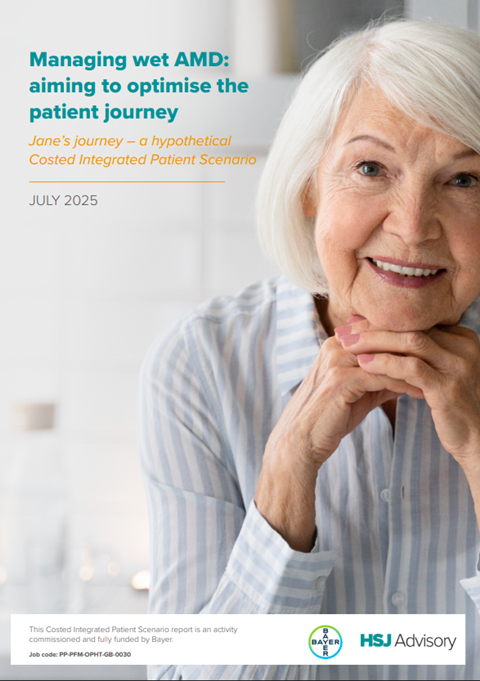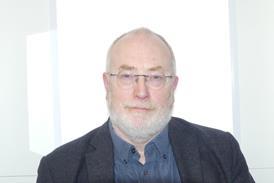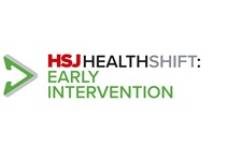Optimising wet AMD care is not just clinically sound – it empowers patients, improves outcomes, and delivers savings for the NHS
Commissioned by and written for Bayer

Macular disease is the leading cause of sight loss in the UK and across the developed world, affecting nearly 1.5 million people in the UK, with age-related macular degeneration (AMD) the most common form.1,2 The prevalence of AMD increases with age, smoking, and other risk factors – and with an ageing population, the number of people affected is expected to rise significantly in the coming years. 1,3
Of particular concern is neovascular (wet) AMD, a rapidly progressing condition that can lead to complete central vision loss within months if left untreated.4 The main treatment for wet AMD is anti-VEGF injections, which help slow down changes in vision, but the condition cannot currently be cured.5 With 26,000 new cases diagnosed annually in the UK, the urgency for effective management is clear.4
HSJ Advisory were recently commissioned by Bayer to bring together medical retina specialists, service managers, payors, and a patient organisation to map out optimal and suboptimal care pathways for a fictional typical patient with wet AMD, Jane, using NHS RightCare methodology. At each stage, the costs of care were modelled in terms of both the financial impact for the local health economy and the broader effect on the patient and her family’s experience.
The clinically-led expert group aimed to highlight potential improvement opportunities in care for patients with wet AMD and the real-world implications of care variation.
Jane’s hypothetical suboptimal – bordering on worst-case – journey reflects a multitude of challenges for patients with wet AMD: a rigid treatment protocol, frequent delays and cancellations, and a lack of psychosocial support. These issues compound over time, leading to anxiety, disease progression, and a growing sense of frustration. The burden of attending regular injection appointments and the lack of clear communication leave patients like Jane feeling isolated, uncertain, and disengaged from their care.
In contrast, the optimal pathway prioritises timely diagnosis and treatment initiation. Effective public health education and accessible information empower a more informed patient population, encouraging individuals to seek help promptly when symptoms arise. Jane’s clinicians have all treatment options available, and Jane receives a more durable treatment agent, potentially allowing her injection intervals to be extended further through the treat-and-extend pathway, reducing the treatment burden for Jane and the hospital eye service. She is supported by virtual reviews and directed to the Macular Society for psychosocial care – helping her stay informed, engaged, and better able to maintain her functional vision.
A financial evaluation of the hypothetical optimal and suboptimal patient journeys reveals a striking difference. By mapping the activities involved in each pathway over a four-year period, the analysis found that managing Jane through the optimal pathway could result in a potential saving of £13,969. This cost difference is largely driven by the increased burden of secondary care activity, higher total drug costs, and the need to manage complications in the suboptimal scenario.
The difference between these potential pathways is stark. The optimal model empowers patients, reduces system strain, and improves clinical outcomes, while delivering significant cost savings. Longer intervals between intravitreal injections have the potential to reduce the need for frequent procedures and follow-ups, ultimately lowering long-term costs. Ensuring all treatment options are available allows clinicians to personalise care, selecting the most appropriate therapy for each patient’s circumstances.
The report suggests that when reviewing treatment options, it is important to take a holistic approach, considering all aspects of patient care, in addition to drug acquisition costs. Financial pressures are real, but when cost-saving measures lead to treatment regimens with high injection frequency, the risk of missed or delayed appointments can undermine treatment adherence and ultimately compromise clinical outcomes. The value of care must be measured not only in pounds but in preserved vision, independence, and quality of life.
This report serves as a call to action for commissioners and providers. By investing in optimal pathways and providing equity of services, including access to all treatments, the NHS can deliver better outcomes for patients like Jane – and do so more efficiently. The opportunity to improve wet AMD care exists at every stage, from community optometrist referral to hospital eye services and beyond. Collaborative, patient-centred approaches are essential to ensuring that no one slips through the cracks.
The full Costed Integrated Patient Scenario report on Jane’s journey with wet AMD can be accessed here. Clicking on this link will take you to an external website hosted by Bayer.

References
1. Macular Society. What is macular disease. Available at: https://www.macularsociety.org/macular-disease/ (accessed July 2025).
2. NICE. Age-related macular degeneration. NICE Guideline 82. 2018. Available at: www.nice.org.uk/guidance/ng82 (accessed July 2025).
3. Pezzullo L, Streatfield J, Simkiss P, Shickle D. The economic impact of sight loss and blindness in the UK adult population. BMC Health Serv Res 2018;18:63.
4. Getting It Right First Time (GIRFT). Ophthalmology: GIRFT Programme national specialty report. 2019. Available at: https://gettingitrightfirsttime.co.uk/wp-content/uploads/2019/12/OphthalmologyReportGIRFT19P-FINAL.pdf (accessed July 2025).
5. NHS. Treatments, age-related macular degeneration (AMD). Available at: https://www.nhs.uk/conditions/age-related-macular-degeneration-amd/treatment/ (accessed July 2025).
PP-PF-OPHT-GB-1458 August 2025




























